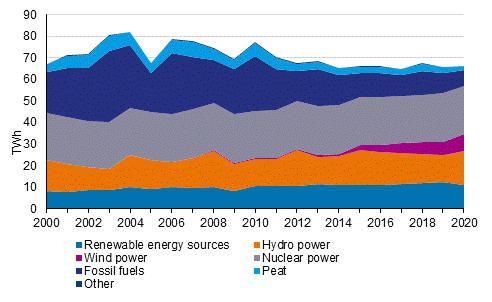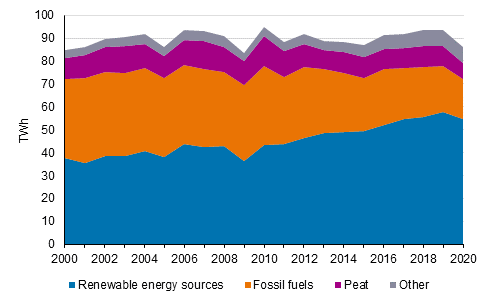Published: 2 November 2021
Over one-half of Finland's electricity was produced with renewable energy sources in 2020
Corrected on 3 November 2021. The corrections are indicated in red.
In 2020, electricity production in Finland amounted to 66.6 TWh, of which 34.7 TWh was produced with renewable energy sources. This corresponds to 52 per cent of Finland's electricity production. In 2020, over one-half of Finland's electricity production was produced with renewable energy sources for the first time in around 50 years. Production of hydro and wind power increased considerably, while electricity produced with wood fuels went down by 13 per cent. The production of both district heat and industrial heat decreased by eight per cent. Sixty-three per cent of the production of district heat and industrial heat was produced with renewable fuels and 28 per cent with fossil fuels and peat. These data derive from the statistics on the production of electricity and heat compiled by Statistics Finland.
Electricity generation by energy source 2000-2020

In 2020, the production of electricity in Finland amounted to 66.6 terawatt hours (TWh) or one billion kilowatt hours (kWh). Total electricity production has stayed almost on level with 2019. Production rose by just 0.5 TWh from the previous year. However, total electricity consumption decreased by 4.5 TWh, amounting to 81.6 TWh in 2020. Of total electricity consumption, 82 per cent was covered by domestic production and 18 per cent by net imports of electricity. Electricity is imported to Finland from the Nordic countries, Russia and Estonia. Net imports of electricity contracted by 25 per cent from the year before. In 2016 to 2019, net imports of electricity were at an exceptionally high level, when Finland's own electricity production covered under 80 per cent of consumption. In 2020, Finland’s production covered 82 per cent of consumption.
Electricity produced with renewable energy sources totalled a record amount of 34.7 TWh. Renewable energy sources covered more than one-half of Finland’s electricity production: 52 %. The growth was mainly caused by increased production of hydro power. Forty-five per cent of renewable electricity was produced with hydro power, 23 per cent with wind power and almost all the rest with wood-based fuels. Thirty-four per cent of electricity was produced with nuclear power, 14 per cent with fossil fuels and peat.
The share of hydro power in electricity production varies yearly according to the water situation. In 2020, electricity produced with hydro power amounted to 15.7 TWh, which is clearly more than in previous years. The same amount of electricity was produced with hydro power last in 2015 and 2016. In 2020, the share of renewable fuels in electricity production decreased by as much as 13 per cent from the year before. Despite this, the amount of electricity produced with renewable energy sources rose due to hydro power and wind power production. The amount of electricity produced with wind power increased by 32 per cent from the previous year and amounted to 7.9 TWh in 2020. In 2020, wind power accounted for 12 per cent of Finland's electricity. The production of solar electricity also grew considerably but its share of total electricity production is still marginal (0.3%).
The amount of electricity produced with fossil fuels decreased by 20 per cent and that of electricity produced with peat by 29 per cent from the previous year. The amount of electricity produced with hard coal decreased by as much as 44 per cent. The amount of electricity produced with natural gas increased slightly (3.6%).
In 2020, the production of electricity with renewable fuels amounted to 10.9 TWh, of which 6.0 TWh were produced with black liquor and 4.3 TWh with other wood-based fuels. Correspondingly, 9.3 TWh of electricity was produced with fossil fuels and peat, which is 2.6 TWh less than in 2019.
Electricity and heat production by production mode in 2020
| Electricity, GWh | District heat, GWh | Industrial heat, GWh | Fuels used, TJ 1) | |
| Separate production of electricity | .. | .. | .. | .. |
| - Hydro power | 15 669 | .. | .. | .. |
| - Wind power | 7 938 | .. | .. | .. |
| - Solar power | 218 | .. | .. | .. |
| - Nuclear power | 22 354 | .. | .. | .. |
| - Condensing power 2) | 2 311 | .. | .. | 26 967 |
| - Total | 48 491 | .. | .. | 26 967 |
| Combined heat and power production | 18 105 | 19 451 | 40 205 | 345 833 |
| Separate heat production | .. | 15 698 | 10 894 | 94 242 |
| Total production | 66 596 | 35 148 | 51 099 | 467 041 |
| Net imports of electricity | 14 977 | .. | .. | .. |
| Total | 81 573 | 35 148 | 51 099 | 467 041 |
2) Condensing power includes condensing power plants, shares of condensing electricity of combined heat and power production plants, and peak gas turbines and similar separate electricity production plants.
The production of district heat totalled 35.1 TWh in 2020, being close to eight per cent lower than in the previous year. The reason for the drop in the production of district heat was the exceptionally warm year and winter in 2020. The use of fossil fuels in the production of district heat decreased by 20 per cent and that of peat by 18 per cent from the previous year. The share of renewable fuels in the production of district heat remained almost unchanged from the year before. Forty-three per cent of district heat was produced with fossil fuels and peat and 44 per cent with renewable fuels. Most of district heat was produced with wood fuels (38%). The second largest energy source in district heat production was the other energy sources group (13.4%). As the largest group other energy sources include flue gas scrubbers and heat pumps. Utilisation of excess heat has grown clearly in recent years. Although the use of peat in the production of district heat decreased from the year before, it still retained its position as the third most important source of energy for district heat production; 13.2 per cent of district heat was produced with peat.
The production of industrial heat was 51.1 TWh in 2020. Production fell by nearly eight per cent from the previous year. The decline in the production of industrial heat was affected by the fallen production of the energy-intensive forest industry. Fifty-four per cent of heat produced for the needs of manufacturing comes from black liquor. In all, 77 per cent of the production of industrial heat was based on renewable fuels. One of the biggest users of industrial heat is the forest industry, which in its production uses its own fuels, like black liquor and other wood fuels. In the chemical, forest and metal industries, part of the use of heat is considered as direct fuel use in the statistics and is thus not visible in the production figures on industrial heat.
District heat and industrial heat production by fuels 2000-2020

The statistics on the production of electricity and heat cover the entire production of electricity connected to the grid. The statistics also include the production of solar electricity and small CHP, which are systems partly outside the grid. From 2015 onwards, the statistics also cover small heat plants, that is, nearly all production of district heat. The statistics do not cover all industrial heat and producers of so-called local heating.
Links:
Statistics Finland's inquiry on production of heat
Finnish Energy’s statistics https://energia.fi/en/statistics
Source: Statistics on production of electricity and heat, Statistics Finland; Electricity production statistics; District heating statistics, Finnish Energy; Association of Finnish Local and Regional Authorities
Inquiries: Tiina Myllymaa 029 551 3336, Minna Niininen 029 551 3549, energia@stat.fi
Head of Department in charge: Katri Kaaja
Publication in pdf-format (375.7 kB)
- Tables
-
Tables in databases
Pick the data you need into tables, view the data as graphs, or download the data for your use.
Appendix tables
- Figures
-
- Appendix figure 1. Electricity generation by energy source 2020 (2.11.2021)
- Appendix figure 2. Electricity generation with renewables 2020 (2.11.2021)
- Appendix figure 3. Electricity generation by production mode 2000-2020 (2.11.2021)
- Appendix figure 4. Electricity generation with renewables 2000-2020 (2.11.2021)
- Appendix figure 5. District heat production by fuels 2000-2020 (2.11.2021)
- Appendix figure 6. Industrial heat production by fuels 2000-2020 (2.11.2021)
- Appendix figure 7. Fuel use in separate electricity production 2019-2020 (2.11.2021)
- Appendix figure 8. Fuel use in combined heat and power production 2019-2020 (2.11.2021)
- Appendix figure 9. Fuel use in separate heat production 2019-2020 (2.11.2021)
Updated 2.11.2021
Official Statistics of Finland (OSF):
Production of electricity and heat [e-publication].
ISSN=1798-5099. 2020. Helsinki: Statistics Finland [referred: 24.12.2025].
Access method: http://stat.fi/til/salatuo/2020/salatuo_2020_2021-11-02_tie_001_en.html

